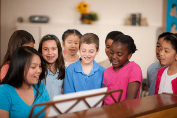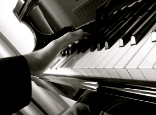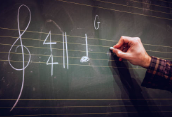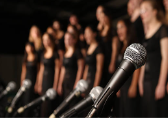The standards for Middle School Choral Music, Beginning Level enable students to obtain musical knowledge and skills in the choral setting. Students begin to develop choral skills, including singing in unison and two-part harmony, with emphasis on vocal production and technique. They learn to read, write, and notate music using basic music theory concepts and perform music from a variety of music styles, composers, cultural influences, and historical periods. Students identify the steps of a creative process and apply emerging music skills to create and notate original work. Students examine career options in music and identify the relationship of choral music to other fine arts. Opportunities are provided for students to participate in local and district music events as appropriate to level, ability, and interest. After-school rehearsal and performances may be required of students.
No Prerequisite Required
Essential Question: How do I use my voice as my instrument?
|
Quarter |
Quarter 1 |
Quarter 2 |
Quarter 3 |
Quarter 4 |
|
Unit Title |
Who am I in Chorus? |
Read, Write, Perform |
Bringing Music to Life |
Making Musical Connections |
|
Image Cue |
 |
 |
 |
 |
|
Focus of the Story |
We begin the year focusing on chorus classroom procedures, routines, and ensemble building using vocal rounds, 2-part harmony and building our musicianship skills by discovering what music looks like and sounds like. |
We will continue to focus on increasing the difficulty of rhythm and pitches in sight reading and keyboarding skills as we prepare the repertoire we will perform in the Winter Concert. |
Through the continued study of music literacy, performance, and the discussion of musical careers, we will discover our personal responses to music including sensory, emotional, intellectual and individual preferences among works of music using music terminology. |
We end the year with making connections with a culminating solo project utilizing aural and literacy skills. The students will learn a song using developed keyboarding skills to prepare and perform a solo and the repertoire we will perform in the Spring Concert. |
|
Transfer Goals |
Understand and apply creative processes to guide the development of ideas, original works, and musical performance. Understand and find meaning in music as a form of community engagement through involvement as a performer, supporter, advocate, and audience member. Explore and connect personal interests, experiences, and aspirations through vocation, advocacy, and arts patronage. Use music literacy to demonstrate understanding of the elements of music and the ways they inform artistic performance and creative expression. |
Understand and apply creative processes to guide the development of ideas, original works, and musical performance. Analyze, interpret, and evaluate musical works from a variety of cultures. Understand and find meaning in music as a form of community engagement through involvement as a performer, supporter, advocate, and audience member. Use music literacy to demonstrate understanding of the elements of music and the ways they inform artistic performance and creative expression. |
Understand and find meaning in music as a form of community engagement through involvement as a performer, supporter, advocate, and audience member. Explore and connect personal interests, experiences, and aspirations through vocation, advocacy, and arts patronage. Use music literacy to demonstrate understanding of the elements of music and the ways they inform artistic performance and creative expression. Use technology as a strategic mechanism for improving music literacy and improving music performance. |
Understand and apply creative processes to guide the development of ideas, original works, and musical performance. Analyze, interpret, and evaluate musical works from a variety of cultures. Understand and find meaning in music as a form of community engagement through involvement as a performer, supporter, advocate, and audience member. Explore and connect personal interests, experiences, and aspirations through vocation, advocacy, and arts patronage. Curate a portfolio of accomplishments, experiences, and performance materials exhibiting oneself as an artist. Use music literacy to demonstrate understanding of the elements of music and the ways they inform artistic performance and creative expression. |
|
Learning Targets |
I can summarize and define the procedures for the chorus classroom. I can collaborate with my classmates. I can recognize and define the best posture for singing. I can sing a piece from the American Heritage tradition. I can identify and write note and rest values. I can follow my part in the vocal score. I can sing the vocal exercises and rounds with supportive breath and proper posture. I can sing using solfege and Kodaly hand signs. I can sing and maintain my part within a round and/or call-and-response. I can reflect on my American the Beautiful performance. |
I can recognize and label the pattern of black and white keys. I can sight-sing a Do, Re, Mi music example. I can sing the rehearsed portions of the concert repertoire. I can rehearse as a member of the ensemble in preparation for the winter concert. I can identify and notate the pitches of a grand staff. I can perform on stage with professional etiquette. I can watch a performance with appropriate audience etiquette. I can describe my personal response to music and a performance. I can dictate rhythms from audiation. I can sight-sing two measures with D,R,M in preparation for the cornerstone. I can create and notate an eight measure rhythmic example. I can correlate emotion to the rhythmic integrity of a composition. |
I can define and apply the Italian dynamics terms. I can define and apply the Italian tempo markings. I can evaluate choral performances using key vocabulary. I can evaluate choral performances using key vocabulary. I can identify how music creates the whole person. I can identify how music is valuable to the community. I can recognize and respond to different intervals. I can compare and describe the diversity of career options in music. |
I can articulate and demonstrate proper audience etiquette. I can play the correct pitches on a keyboard from notated music. I can articulate and demonstrate professional performance and stage expectations. I can sing concert repertoire while adding appropriate movements. I can sing concert repertoire while adding appropriate movements. I can sing the concert repertoire with appropriate ensemble technique. I can form personal responses to music and performances. I can perform an eight measure melody on a keyboard. I can outline, plan, and prepare and perform a solo performance. I can respond to peer performances in an appropriate manner. I can reflect on my solo performance. I can reflect on the school year. I can submit a final assessment to display growth over the year. |
